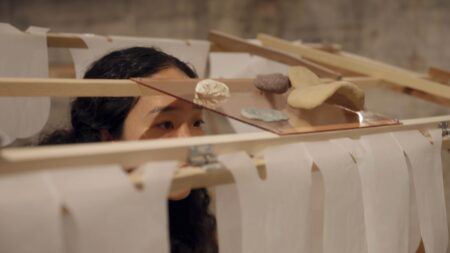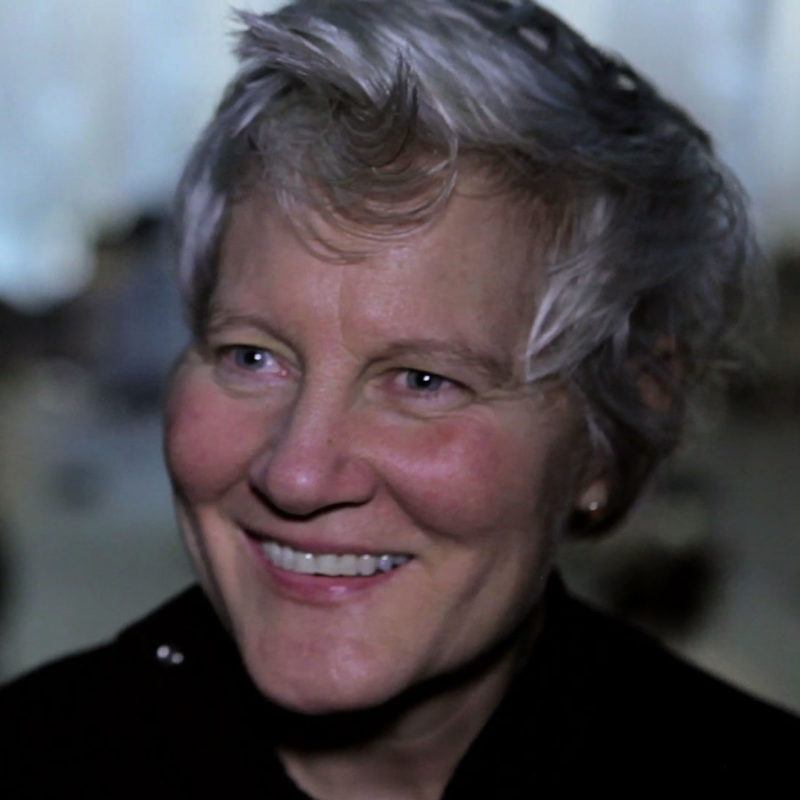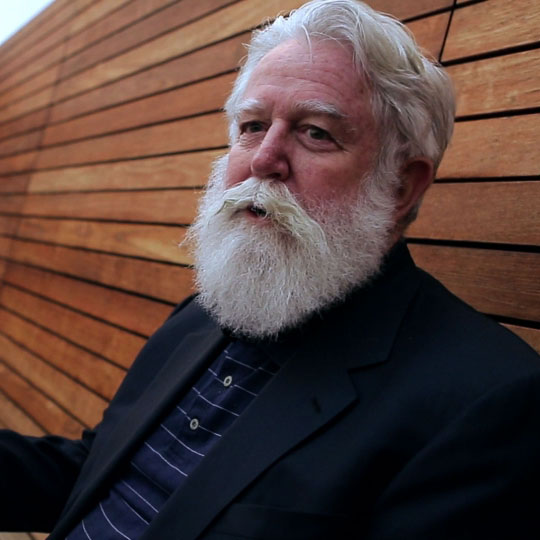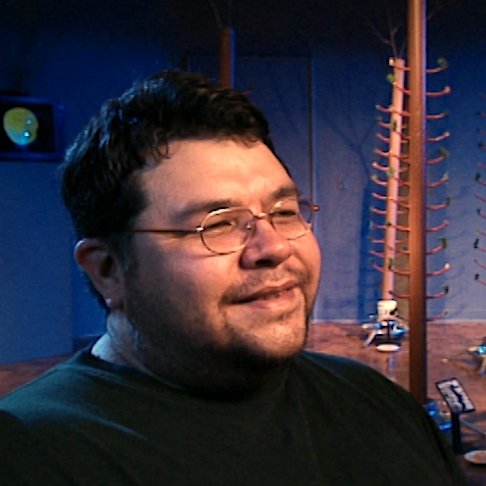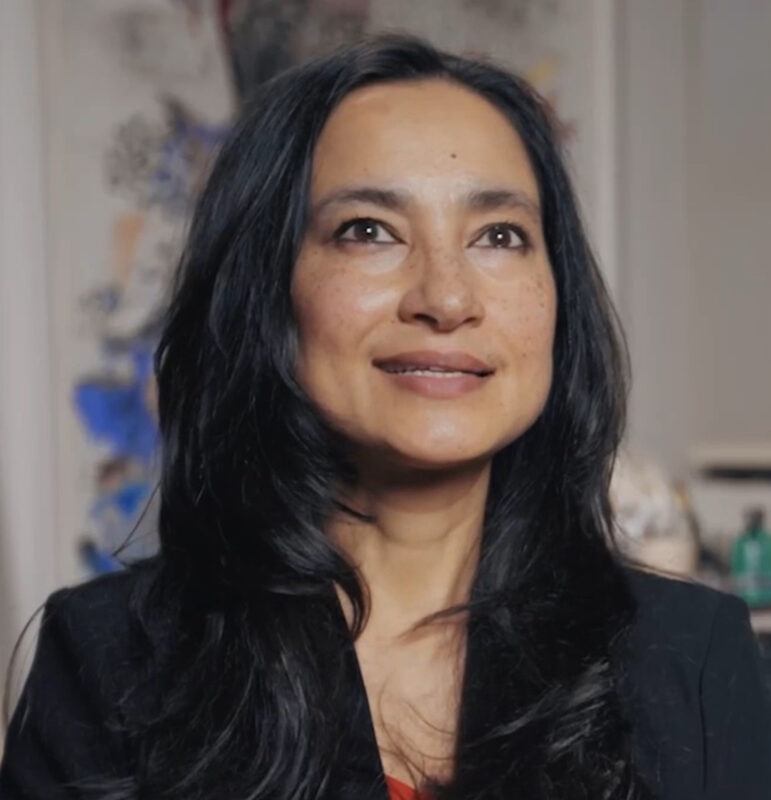Continue playing
(Time remaining: )
Play from beginning
Continue playing "{{ controller.videos[controller.getVideo(controller.currentVideo)].segmentParentTitle}}"
{{controller.videos[controller.getVideo(controller.currentVideo)].title}} has ended.
Spirituality
“Spirituality is such a vibrant and integral part of our lives that even our changing times and all the apparent obstacles have not stifled the powerful partnership of spirituality and art in the modern era,” writes Lynn M. Herbert in her essay for the Companion Book to the Art in the Twenty-First Century series. “The realm of the spiritual is mysterious and inviting,” writes Herbert, “It is a place where we are encouraged to explore the unknown.”
More information and creditsCredits
Created by: Susan Sollins & Susan Dowling. Executive Producer & Curator: Susan Sollins. Executive Producer: Susan Dowling. Series Producer: Eve-Laure Moros Ortega. Associate Producer: Migs Wright. Production Coordinator: Laura Recht. Researcher: Quinn Latimer & Wesley Miller. Director: Deborah Shaffer. Editor: Kate Taverna. Director of Photography: Bob Elfstrom, Ken Kobland, Joel Shapiro, & Dyanna Taylor. Additional Photography: Chip Nusbaum & Anita Sieff. Assistant Camera: Ulli Bonnekamp, John Griffiths, Glen Piegari, Kipjaz Savoie, & Ben Wolf. Sound: Ray Day, John Fintel, Alan Sawyer, Scott Szabo, J.T. Takagi, & Eric Williams. Gaffer/Grip: Steve Carrillo, Kent Eanes, Dennis Hollyfield, Greg Szabo, & Lieven Van Hulle. Production Assistant: Mark Chevarria, Anya Dehr-Turrell, Chris Dowling, Heather Glass, Melissa Morgan, & Erin Wile. Animation Stand Photographer: Marcos Levy & City Lights. Assistant Avid Editor: Heather Burak & Matt Prinzig.
Introductory Segment | Artwork: Beryl Korot. Cast: S. Epatha Merkerson.
Creative Consultant: Ed Sherin. Art Design and Direction: Open, New York. Animation, Visual Effects & Compositing: Spontaneous Combustion. On-Line Editor: Don Wyllie & Frame:Runner NYC. Composer: Peter Foley. Music Supervisor: John Yaffé. Sound Editing: Margaret Crimmins, Greg Smith, & Dog Bark Sound. Sound Mix: Tony Volante & Soundtrack, New York. Post-Production Supervisor: Michael Weingrad & Keir Randall.
Artworks courtesy of: John Feodorov; Ann Hamilton; Shahzia Sikander; James Turrell; Deitch Projects; Whitney Museum of American Art; Lisa Sette Gallery; Sacred Circle Gallery/Daybreak Star; & Seattle Arts Commission. Archival photo of James Turrell courtesy of: Jeffery J. Kozera. Archival footage courtesy of: ZCZ Films Ltd.
Special Thanks: Anne C. Baker; Alison Beall; Michael Bond; The Brotman Family; William Bush; City Lights; Catherine Dee; Susan Delson; Krista Ferguson; Claudia Garthwait; Barbara Gladstone; Thomas G. Grace; Jill Hartz, Bayly Art Museum; Russell Hassell; Sean Kelly Gallery; Bruce Mac Corkindale; Cara Mertes; Margarita Moreno; Office of Housing, City of Seattle; Chris Pullman; Lyn Bolen Rushton; Sacred Circle Gallery/Daybreak Star; Azra Sikander; Gabe Silverman; Brooke Singer; Skystone Foundation; Tamberelli Video; Nancy Taylor; Darin Webb; & Whitney Museum @ Philip Morris.
Interns: Maytal Ahrony, Joyce Alcantara, Christina Darcy, Leslie Fritz, Johanna Goldfeld, Susannah Gust, Sage Lehman, Kelly McCoy, Genevieve Mercatante, Jeff Seelbach, & Stacy Wu.
Public Relations: Kelly & Salerno Communications. Legal Counsel: Albert Gottesman.
Major underwriting for Season 1 of Art in the Twenty-First Century is provided by Robert Lehman Foundation, PBS, National Endowment for the Arts, Corporation for Public Broadcasting, Rockefeller Brothers Fund, Agnes Gund and Daniel Shapiro, The Allen Foundation for the Arts, The Broad Art Foundation, The Jon and Mary Shirley Foundation, Bagley Wright Fund, The Rockefeller Foundation, The Andy Warhol Foundation for the Visual Arts, The Horace W. Goldsmith Foundation, and The Foundation-to-Life.
Closed captionsAvailable in English, German, Romanian, Italian, Japanese, Korean, Chinese, Italian
Through the Art21 Translation Project, multilingual audiences from around the globe can contribute translations, making Art21 films more accessible worldwide.
Interested in showing this film in an exhibition or public screening? To license this video please visit Licensing & Reproduction.
Ann Hamilton’s sensual installations often combine evocative soundtracks with cloth, filmed footage, organic material, and objects such as tables. She is as interested in verbal and written language as she is in the visual, and sees the two as related and interchangeable. In recent work, she has experimented with exchanging one sense organ for another: the mouth and fingers, for example, become like an eye, with the addition of miniature pinhole cameras.
Beryl Korot was born in 1945 in New York City, where she lives and works. She graduated from Queens College in 1967 with a BA in English literature. In her practice, Korot explores how information is encoded and transmitted through systems of lines, grids, and patterns throughout human history. Drawing upon traditions and strategies found in weaving, print media, and video recording, the artist develops artworks that uniquely visualize the intersections of history, language, and technology.
James Turrell was born in 1943 in Los Angeles and currently lives in Flagstaff, Arizona. He received a BA in psychology from Pomona College in 1965 and an MA in art from Claremont Graduate School in 1973. Influenced by his Quaker upbringing, and interested in the relationship between light and space, the artist creates installations and architectural structures that use natural light and artificial color to manipulate the experience of seeing. In doing so, Turrell’s art evokes feelings of transcendence and the sublime, encouraging viewers to practice contemplation, patience, and meditation.
John Feodorov was born in 1960 in Los Angeles, California, and currently lives and works in Seattle, Washington. Feodorov received his BFA in drawing and painting from California State University and his MFA in Visual Art from Vermont College. Brought up in the suburbs of Los Angeles, he spent summers visiting his grandparents on a Navajo reservation in New Mexico. As a child, Feodorov experienced the cultural contradictions between his dual heritages, being of mixed Navajo (Diné) and Euro-American descent. He also observed the stereotypes present in American culture, where Native Americans have been idealized as the living embodiment of spirituality by New Age consumerists. His work addresses this clichéd modern archetype through a humorous interjection of “sacred” items into recognizable consumer products.
Shahzia Sikander specializes in Indian and Persian manuscript painting, a traditional, technique-driven style that Sikander imbued with a personal context and history, blending the Eastern focus on precision and methodology with a Western emphasis on creative, subjective expression. In doing so, Sikander transported manuscript painting into the realm of contemporary art. Expanding the manuscript painting to the wall, Sikander also creates murals and installations, using tissue-paper-like materials that allow for a more free-flowing style. Utilizing performance and various media and formats to investigate issues of border crossing, she seeks to subvert stereotypes of the East and, in particular, the Eastern Pakistani woman.
“When I’m making work, there’s a point where I can’t see it. And then there’s that moment where you can see it—it’s like it bites you—and you think it might be beautiful.”
Ann Hamilton
